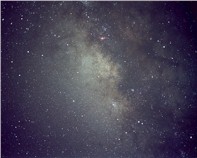
Point your camera skyward |
Starry Skies: Set your camera to take a long exposure (15
seconds or more). Aim it at an area of the sky with a lot of stars, and just go
"click". See what happens. Many of today's modern digital cameras
will yield pleasing results. You'll need to set the camera to its maximum light
sensitivity and configure it to take a long exposure (15 seconds or more). Some
cameras are equipped with a "B" (for Bulb) setting. This keeps the camera
shutter open when you click and doesn't close it again until you either let go of the
button or click it again. You can see that this is the best type of camera because
very long exposures are possible. The quality will depend a lot on how good
your camera is at capturing detail in the dark. If your camera can't take exposures
lasting at least ten seconds then a good result is not likely. Set your camera on a
tripod for the best results, holding the camera by hand is not the best because you won't
be able to hold it steady enough. Use a tripod or a high fence post. Unless
you buy an equatorial mount or you build a Barn Door
tracker you will get star trailing. You can even use no tracking at all with
very short exposures and a very sensitive camera like
this. The linked photo was taken with a Canon 350D sitting on a block of wood.
The 30 second exposure (ISO800) produced a good result which shows the Milky Way,
Southern Cross, the two pointers, the Coal Sack, the Eta Carina Nebula and a heap of
stars). The exposure is so short and the field of view (18mm lens) is so wide that
star trails are only just visible. This sort of experimentation is what gets you
started. |
 Through a telescope, prime focus, afocal or eyepiece
projection |
If you wish to photograph planets, double stars, nebulae or galaxies this
will require several new web pages (coming soon) to explain in detail. You
must also be willing to part with some hard cash so you can buy stuff.
Compared to fishing astronomy is cheap (think boats, rods, reels, petrol, four wheel
drive, etc..) Heck, you're saving money.
If you already have a good equatorial mounted telescope, and you want to know how to get
started in astrophotography then click here. |

